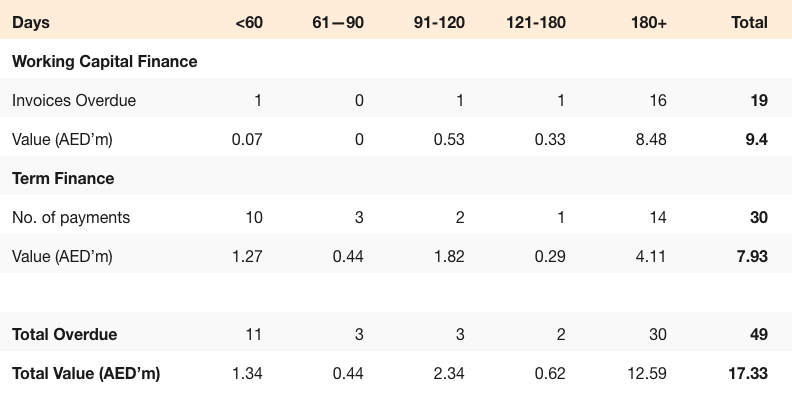Over the past few years, a surge in the amount of research, number of organizations and events dedicated to the small to medium sized enterprise (SME) space has taken the world by storm. A common theme has been the essential roles SMEs play in a nation’s economic fabric as well as their crucial role in advancing innovation, growth and prosperity. The buzz and the growing interest has rallied stakeholders and raised awareness of the importance of SMEs. But more than anything, the newfound interest in SMEs has highlighted the significant challenges they face.
Chief among those challenges remains access to capital. In the UAE and the wider Middle East region, many small businesses are simply unable to access favourable financing terms or secure reasonable credit terms in a timely manner. The difficulty in applying for financing from banks, their fees and the rates they charge all make traditional financing prohibitive for most small businesses.
This severely impedes SMEs’ ability to grow, expand and reach their potential, with negative consequences for economic growth, innovation, and macro-economic robustness.
With banks and other conventional lenders reluctant to take chances on small-business loans, numerous reports have highlighted the fact that this gap is largely the result of a mismatch between the needs of the small businesses and the supply of financial services which are more easily accessed by larger firms.
This is even more pronounced in emerging markets like the UAE, which has a healthy SME sector of about 300,000 SMEs that account for around 60% of GDP and over 90% of employment. Yet while they form the backbone of the economy, they still suffer from a lack of funding options that give them the credit they need with suitable terms. This is supported by the International Finance Corporation’s (IFC) estimate that the current SME funding gap in the MENA region is valued at around USD$260 billion.
The massive credit gap that has resulted is driving a critical need for alternative finance solutions to fuel growth in this critically underserved sector of the economy.
A few years ago, the considerable success and growth of the Peer-to-Peer (P2P) finance model in the UK and US, where the concept was first launched 10 years ago through companies like Zopa, Prosper and Lending Club, caught my attention. The explosive rise of these companies and rapid development of the model in more advanced markets had already received great traction in the media and with the public. I decided to do some homework and started speaking with SME owners in the UAE and looking into the available sources of financing for small business here to consider the viability of the P2P concept locally.
Borrowing from tried and tested concepts in crowdfunding, peer-to-peer (P2P) finance is a simple, novel way of raising money using the Internet’s network-effect to get a large number of people contributing a small amount of money individually. This reduces the risks for investors and pools money together, helping eliminate the cost and complexity of conventional finance. This approach, supported by a robust credit assessment model and legal structure, means businesses end up getting access to lower cost finance much more quickly and investors get better returns on their money while diversifying their risk.
Having operated an SME myself, I know the frustrations faced by SMEs trying to get credit to fuel their growth.
The allure of peer-to-peer financing is obvious and makes it highly attractive for businesses looking for lower-interest finance than they can secure through a bank, as well as for investors who want higher-than-market, steady returns. The online nature and technology efficiencies of P2P platforms significantly reduces the cost of transaction versus their bricks-and-mortar counterparts, enabling them to provide a source of finance for smaller businesses looking for smaller amounts.. The fact that individual investors bid and compete to finance business requests means that an auction (think reverse eBay) ensures the lowest blended rate is offered to the SME. Additional factors adding to the model’s appeal include the ability to quickly make a financing request, plus its ease-of-use and transparency, especially when compared to traditional sources of finance.
The results of my research and examination of the UAE market confirmed my assumptions and I started identifying the team, including the former CEO of Emirates NBD Rick Pudner, and building the platform in 2013. Last November, Beehive was launched as the first peer-to-peer financing platform in the UAE, authorised and regulated by the DMCC, with a vision to transform the local credit market and increase the options that SMEs have to obtain finance. With an operational structure modelled on global best practice and robust investor protections in place, Beehive’s regional ambition is connecting for growth.
Through the use of innovative technology, Beehive set out to create a marketplace that directly connects established businesses with smart investors so that SMEs get faster access to lower cost finance and investors get better returns and manage risk by diversifying their investments. Businesses seeking investment between AED 100,000 and AED 500,000+ gain access to individual investors who bid to provide the financing, choosing how much they will finance and at which rate. The businesses receive funding typically in 14 to 18 days, depending on the length of auction, and investors receive monthly repayments at target rates of between 8% and 20%.
The response to Beehive and the P2P concept has so far been tremendous, with SMEs and all kinds of investors supporting the launch of our business model and helping to spread the word in the UAE. The timing was absolutely right for the UAE to embrace P2P finance, and to provide a template for the rest of the region as to how the P2P model serves to benefit businesses, investors and the wider economy.
To date, a wide spectrum of businesses have used the Beehive platform, from an HR consultancy, digital agency and a coffee supplier, to a pet supplier and plastic manufacturer. Our investor base is equally as varied and includes investors across different nationalities and age groups, each choosing to bid different amounts of money across the Beehive platform.
Since Beehive’s launch, we’ve also worked on developing ancillary features like a secondary market that provides liquidity for investors on the platform, as well as an Invoice Financing product enabling SMEs to boost their working capital and improve cash flow. The later solution also presents a great substitute for larger investors such as funds and asset managers to generate alternative returns, while supporting SMEs in the UAE economy. We are excited about the upcoming business finance opportunities we still have in the pipeline.
As we helped pioneer P2P to the local market early on, we worked to help educate the market about peer-to-peer and how Beehive can help. Getting the message across about the benefits of P2P finance to a wider audience has been essential to driving adoption and comfort with the P2P concept.
As the P2P finance industry turns 10 years old this month, it still remains a burgeoning industry. But there is general consensus that P2P finance platforms are bridging a gap, enabling smaller businesses and ordinary people to seek finance and invest more easily. Today, significant investments and big players are looking to enter the market and participate on the fast expanding P2P finance sector, with several established financial institutions vying to embrace its promise of greater efficiency and choice.
Source: Wealth Monitor




